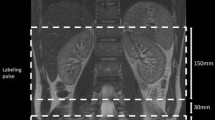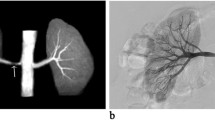Abstract
Purpose
To prospectively determine the repeatability of noncontrast-enhanced renal arterial angiography with steady-state free precession (SSFP) and time-spatial labeling inversion pulse (Time-SLIP), and to compare the visibility of renal artery and its branches when different locations of tagging pulse were placed.
Methods
Thirty-six young healthy volunteers were enrolled in this study and were twice examined by noncontrast-enhanced renal arterial angiography with SSFP and Time-SLIP in 1.5T MR scanner. Measurement error and repeatability were assessed for each of the five major parameters [vessel-to-kidney ratio (VKR), grade of renal arterial branching, grading of image quality, diameter and area of the main renal artery] using the Bland–Altman plot. Two independent observers recorded the values of the parameters; Inter- and intra-observer agreement was assessed using the intraclass correlation coefficients (ICCs). The same parameters, acquired at the tagging pulse placed just above the superior poles of both kidneys or closer to the main renal arteries, were compared using the Wilcoxon signed-rank test.
Results
Grading of arterial branching by the Time-SLIP SSFP was satisfactorily reproducible with the mean score of greater 3.83 indicating the visibility of branches within the renal parenchyma. The image quality was excellent for Segment I (the main trunk of renal artery) and good for Segment II (segmental branches pre renal parenchyma) and III (vessels within the renal parenchyma) with a satisfying repeatability between two examinations and a good inter- and intra-observer agreement. The ICCs for the inter- and intra-observer measurements of both diameter and area of the main arteries ranged from 0.781 to 0.934, indicating very good agreement. The repeatability of VKR was poor between the two examinations and at the two different tagging pulse locations. The position of tagging pulse in the origination of the main renal arteries was better than in the superior poles of kidneys as it provided a better visualization of arterial branches.
Conclusion
Noncontrast-enhanced renal artery angiography with SSFP and Time-SLIP yields reliable and reproducible visualization of normal renal arteries. Localization of the tagging pulse closer to the main renal arteries provides better visibility of renal artery and its branches than the tag placement just above the superior poles of both kidneys.


Similar content being viewed by others
References
Granata A, Fiorini F, Andrulli S, et al. (2009) Doppler ultrasound and renal artery stenosis: an overview. J Ultrasound 12:133–143
Plouin PF, Rossignol P, Bobrie G (2001) Atherosclerotic renal artery stenosis: to treat conservatively, to dilate, to stent, or to operate? J Am Soc Nephrol 12:2190–2196
Bloch MJ, Basile J (2003) The diagnosis and management of renovascular disease: a primary care perspective. Part I. Making the diagnosis. J Clin Hypertens 5:210–218
Safian RD, Textor SC (2001) Renal-artery stenosis. N Engl J Med 344:431–442
Young N, Chi KK, Ajaka J, et al. (2002) Complications with outpatient angiography and interventional procedures. Cardiovasc Intervent Radiol 25:123–126
Vasbinder GB, Nelemans PJ, Kessels AG, et al. (2001) Diagnostic tests for renal artery stenosis in patients suspected of having renovascular hypertension: a meta-analysis. Ann Intern Med 135:401–411
Fleischmann D (2003) Multiple detector-row CT angiography of the renal and mesenteric vessels. Eur J Radiol 45(Suppl 1):S79–S87
Mittal TK, Evans C, Perkins T, Wood AM (2001) Renal arteriography using gadolinium enhanced 3D MR angiography: clinical experience with the technique, its limitations and pitfalls. Br J Radiol 74:495–502
Shiragami K, Fujii Z, Sakumura T, et al. (2008) Effect of a contrast agent on long-term renal function and the efficacy of prophylactic hemodiafiltration. Circ J 72:427–433
Kawashima S, Takano H, Iino Y, Takayama M, Takano T (2006) Prophylactic hemodialysis does not prevent contrast-induced nephropathy after cardiac catheterization in patients with chronic renal insufficiency. Circ J 70:553–558
Cowper SE, Robin HS, Steinberg SM, et al. (2000) Scleromyxoedema-like cutaneous diseases in renal-dialysis patients. Lancet 356:1000–1001
Marckmann P, Skov L, Rossen K, et al. (2006) Nephrogenic systemic fibrosis: suspected causative role of gadodiamide used for contrast-enhanced magnetic resonance imaging. J Am Soc Nephrol 17:2359–2362
Argalia G, Cacciamani L, Fazi R, Salera D, Giuseppetti GM (2004) Contrast-enhanced sonography in the diagnosis of renal artery stenosis: comparison with MR-angiography. La Radiologia Medica 107:208–217
Borrello JA, Li D, Vesely TM, et al. (1995) Renal arteries: clinical comparison of three-dimensional time-of-flight MR angiographic sequences and radiographic angiography. Radiology 197:793–799
Loubeyre P, Trolliet P, Cahen R, et al. (1996) MR angiography of renal artery stenosis: value of the combination of three-dimensional time-of-flight and three-dimensional phase-contrast MR angiography sequences. AJR Am J Roentgenol 167:489–494
Kaandorp DW, Vasbinder GB, de Haan MW, Kemerink GJ, van Engelshoven JM (2000) Motion of the proximal renal artery during the cardiac cycle. J Magn Reson Imaging 12:924–928
Katoh M, Spuentrup E, Stuber M, et al. (2005) Free-breathing renal magnetic resonance angiography with steady-state free-precession and slab-selective spin inversion combined with radial k-space sampling and water-selective excitation. Magn Reson Med 53:1228–1233
Miyazaki M, Takai H, Sugiura S, et al. (2003) Peripheral MR angiography: separation of arteries from veins with flow-spoiled gradient pulses in electrocardiography-triggered three-dimensional half-Fourier fast spin-echo imaging. Radiology 227:890–896
Weber OM, Martin AJ, Higgins CB (2003) Whole-heart steady-state free precession coronary artery magnetic resonance angiography. Magn Reson Med 50:1223–1228
Coenegrachts KL, Hoogeveen RM, Vaninbroukx JA, et al. (2004) High-spatial-resolution 3D balanced turbo field-echo technique for MR angiography of the renal arteries: initial experience. Radiology 231:237–242
Garcia DM, Duhamel G, Alsop DC (2005) Efficiency of inversion pulses for background suppressed arterial spin labeling. Magn Reson Med 54:366–372
Utsunomiya D, Miyazaki M, Nomitsu Y, et al. (2008) Clinical role of non-contrast magnetic resonance angiography for evaluation of renal artery stenosis. Circ J 72:1627–1630
Maki JH, Wilson GJ, Eubank WB, et al. (2007) Navigator-gated MR angiography of the renal arteries: a potential screening tool for renal artery stenosis. AJR Am J Roentgenol 188:W540–W546
Aytac SK, Yigit H, Sancak T, Ozcan H (2003) Correlation between the diameter of the main renal artery and the presence of an accessory renal artery: sonographic and angiographic evaluation. J Ultrasound Med 22:433–439 (quiz 440–432)
Bland JM, Altman DG (1986) Statistical methods for assessing agreement between two methods of clinical measurement. Lancet 1:307–310
Barkhausen J, Hunold P, Jochims M, et al. (2002) Comparison of gradient-echo and steady state free precession sequences for 3D-navigator MR angiography of coronary arteries. RoFo 174:725–730
Spuentrup E, Katoh M, Buecker A, et al. (2004) Free-breathing 3D steady-state free precession coronary MR angiography with radial k-space sampling: comparison with cartesian k-space sampling and cartesian gradient-echo coronary MR angiography: pilot study. Radiology 231:581–586
Shimada K, Isoda H, Okada T, et al. (2009) Unenhanced MR portography with a half-Fourier fast spin-echo sequence and time-space labeling inversion pulses: preliminary results. AJR Am J Roentgenol 193:106–112
Shimada K, Isoda H, Okada T, et al. (2009) Non-contrast-enhanced hepatic MR angiography with true steady-state free-precession and time spatial labeling inversion pulse: optimization of the technique and preliminary results. Eur J Radiol 70:111–117
Shimada K, Isoda H, Okada T, et al. (2009) Non-contrast-enhanced MR angiography for selective visualization of the hepatic vein and inferior vena cava with true steady-state free-precession sequence and time-spatial labeling inversion pulses: preliminary results. J Magn Reson Imaging 29:474–479
Satogami N, Okada T, Koyama T, et al. (2009) Visualization of external carotid artery and its branches: non-contrast-enhanced MR angiography using balanced steady-state free-precession sequence and a time-spatial labeling inversion pulse. J Magn Reson Imaging 30:678–683
Wheaton AJ, Miyazaki M (2012) Non-contrast enhanced MR angiography: physical principles. J Magn Reson Imaging 36:286–304
Herborn CU, Watkins DM, Runge VM, et al. (2006) Renal arteries: comparison of steady-state free precession MR angiography and contrast-enhanced MR angiography. Radiology 239:263–268
Kanki A, Ito K, Tamada T, et al. (2013) Corticomedullary differentiation of the kidney: evaluation with noncontrast-enhanced steady-state free precession (SSFP) MRI with time-spatial labeling inversion pulse (Time-SLIP). J Magn Reson Imaging 37:1178–1181
Parienty I, Rostoker G, Jouniaux F, et al. (2011) Renal artery stenosis evaluation in chronic kidney disease patients: nonenhanced time-spatial labeling inversion-pulse three-dimensional MR angiography with regulated breathing versus DSA. Radiology 259:592–601
Xu JL, Shi DP, Li YL, et al. (2011) Non-enhanced MR angiography of renal artery using inflow-sensitive inversion recovery pulse sequence: a prospective comparison with enhanced CT angiography. Eur J Radiol 80:e57–e63
Wyttenbach R, Braghetti A, Wyss M, et al. (2007) Renal artery assessment with nonenhanced steady-state free precession versus contrast-enhanced MR angiography. Radiology 245:186–195
Miyazaki M, Akahane M (2012) Non-contrast enhanced MR angiography: established techniques. J Magn Reson Imaging 35:1–19
Conflict of interest
All of the authors have no conflict of interests to disclose.
Author information
Authors and Affiliations
Corresponding author
Rights and permissions
About this article
Cite this article
Zhang, Y., Xing, Z., Liu, Y. et al. Nonenhanced renal MR angiography using steady-state free precession (SSFP) and time-spatial labeling inversion pulse (Time-SLIP): repeatability and comparison of different tagging location. Abdom Imaging 39, 1000–1008 (2014). https://doi.org/10.1007/s00261-014-0126-9
Published:
Issue Date:
DOI: https://doi.org/10.1007/s00261-014-0126-9




